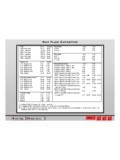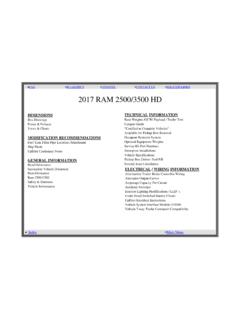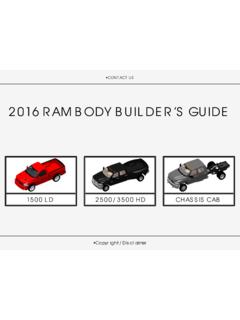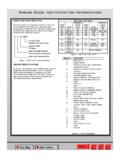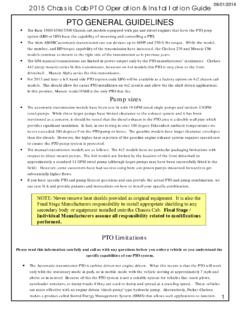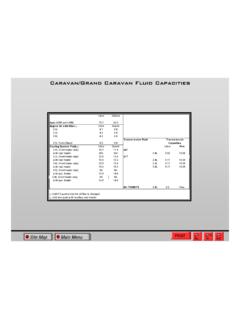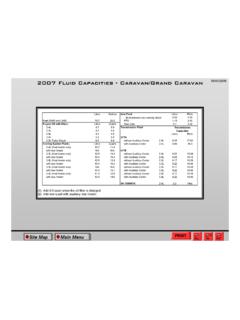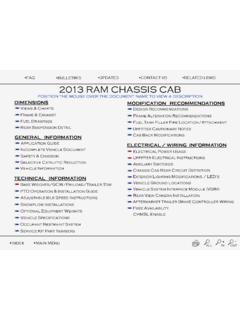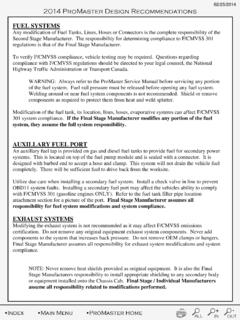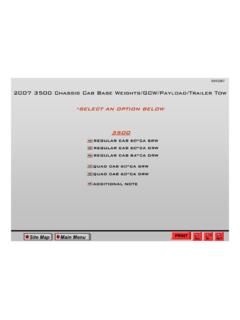Transcription of Wiring Code Identification Information - Ram Body Builder
1 Main MenuSite MapALLIN+OUT-PRINTW iring code Identification InformationWIRE code Identification Each wire shown in the diagrams contains a code (Fig. 1) which identifies the main circuit, part of the main circuit, gauge of wire, and color. The color is shown as a two-letter code , which can be identified by referring to the Wire Color code Chart (Fig. 2). Figure 1 Wire Color code Identification CIRCUIT Identification All circuits in the diagrams use an alphanumeric code to identify the wire and its function (Fig. 3). To identify which circuit code applies to a system; refer to the Circuit Identification code Chart. This chart shows the main circuits only and does not show the secondary codes that may apply to some models.
2 Figure 2 Wire Color code Chart Figure 3 Circuit Identification COLOR OF WIRE(Light Blue with Yellow Tracer)GAUGE OF WIRE(18 Gauge)PART OF MAIN CIRCUIT(Varies Depending on Equipment)MAIN CIRCUIT IDENTIFICATIONALB/YL218 ColorCodeColorStandardTracerColorColorCo deColorStandardTracerColorBLBLUEWTORORAN GEBKBKBLACKWTPKPINKBK or WTBRBROWNWTRDREDWTDBDARKBLUEWTTNTANWTDGD ARKGREENWTVTVIOLETWTGYGRAYBKWTWHITEBKLBL IGHTBLUEBKYLYELLOWBKLGLIGHTGREENBK*Wire Color code ChartWITH TRACERCIRCUITFUNCTIONA- Battery FeedB- Brake ControlsC- Climate Controls, EBL, Heated Mirror, Windshield and SeatD- Diagnostic Circuits, Communications, AntennasE- Dimming Illumination CircuitsF- Switched Ignition FeedsG- Gauges, Displays, Monitoring, Body Sensors, Resistive Mux'd SwitchesH-OpenI-Not UsedJ-OpenK- Power Train Control ModuleL- Exterior Lighting.
3 Headlamp LevelingM- Interior and Courtesy LightingN- Fuel Pump, Radiator FanO-Not UsedP- Power Option, Seats, Recliner, Lumbar, Mirrors, Door LocksQ- Power Options, Windows, Vents, Sunroof, Tops, Trunk, Liftgate, Sliding DoorsR-Restraint SystemsS- Suspension/SteeringT- Starter, Transmission, Transaxle, Transfer CaseU-OpenV- Speed ControlW- Washer, WiperX- Sound Systems, HornY-OpenZ- GroundsWiring code Identification InformationMain MenuSite MapALLIN+OUT-PRINTCONNECTORS Connectors shown in the diagrams are identified using the international standard arrows for male and female terminals (Fig. 4). A connector identifier is placed next to the arrows to indicate the connector number (Fig.)
4 4). For viewing connector pin outs, with two terminals or greater, refer to section 8W-80. This section identifies the connector by number and provides terminal numbering, circuit Identification , wire colors and functions. All connectors are viewed from the terminal end unless otherwise specified. To find the connector location in the vehicle, refer to section 8W-90. This section uses the connector Identification number from the Wiring diagrams to provide a figure number reference. TAKE OUTS The abbreviation T/O is used in the component location section to indicate a point in which the Wiring harness branches out to a component. ELECTROSTATIC DISCHARGE (ESD) SENSITIVE DEVICES All ESD sensitive components are solid state and a symbol (Fig.
5 5) is used to indicate this. When handling any component with this symbol, comply with the following procedures to reduce the possibility of electrostatic charge buildup on the body and inadvertent discharge into the component. If it is not known whether the part is ESD sensitive, assume that it is. 1) Always touch a known ground before handling the part. This should be repeated while handling the part and more frequently after sliding across a seat, sitting down from a standing position or walking a distance. 2) Avoid touching electrical terminals of the part, unless instructed to do so by a written diagnostic procedure. 3) When using a voltmeter, be sure to connect the ground lead first.
6 4) Do not remove the part from its protective packing until it is time to install the part. 5) Before removing the part from its package, ground the package to a known good ground on the vehicle. Figure 4 Electrostatic Discharge Symbol Figure 5 Electrostatic Discharge Symbol Wiring code Identification InformationMain MenuSite MapALLIN+OUT-PRINTWIRING GUIDELINES FOR 2006 DODGE TRUCK AFTERMARKET/BODY BUILDERS 1. Introduction These guidelines are intended as an aid in Wiring design. It is not an all-inclusive list or a substitute for common sense. It is to be used as a supplement to existing good design practices and standards. Additional Information is in the Referenced Publications section.
7 Performing a Failure Mode and Effects Analysis (FMEA) on each completed Wiring design is a good practice to confirm the integrity of the design. This document will be revised periodically, based on advances in technology and operating practices. 2. Electrical System A. Modification to the existing vehicle Wiring should be done only with extreme caution. The effects on the completed vehicle electrical system must be considered. Any additional circuitry should be evaluated to ensure that adequate circuit protection provisions will be in place and that feedback loops will not be created. B. The following affects the selection of wire gauge for a particular application: Wire size selection is affected by circuit protection requirements, power distribution requirements and mechanical handling requirements Wire size selection is affected by long-range heat aging characteristics resulting from current loading C.
8 Circuit Protection When adding loads to a base vehicle s protected circuit; be sure that the total electrical load through the base vehicle fuse or circuit breaker is less than the derated device rating. The total electrical load is the sum of the base vehicle circuit current requirement added to the add-on component(s) current requirements. Confirm the load with an ammeter. DO NOT increase the rating of a factory-installed fuse or circuit Any added circuitry must be protected by either the base vehicle fuse or circuit breaker or by a similar device installed by the body Builder . In-line fuses should be readily accessible All battery circuits, except the starter motor, must have circuit protection Protections devices for high current loads such as a winch or snowplow motor must be connected directly to the vehicle battery and not to the vehicle power distribution center or other downstream components.
9 Circuit protection devices are designed to protect the Wiring . They may not necessarily protect other components in the event of a short circuit. 3. Harness Routing A. Connectors should be readily accessible, where feasible, to permit ease of installation and serviceability. Accessibility to connectors is good design practice. Examples include fuse blocks, relays, modules, electrical components, junction blocks and ground blocks. B. Provide sufficient wire lengths to permit wire harness serviceability. However, excess lengths should be kept to a minimum to prevent: trapping and pinching during assembly; poor fit and finish; and buzzes, squeaks and rattles. C. Circuits attached to parts or structures that have dynamic (moving) properties must consider adequate slack and strain relief to prevent damage.
10 A few examples are the engine block, door and liftgate harness, shocks, struts and tilt steering columns. Endurance testing must be performed to ensure that designs meet life test criteria. D. Wiring assemblies must not be within one inch (25 mm) of any hot surface or moving mechanism. Movement due to engine rocking will require a greater distance than one inch. Engineering discretion must be used to determine if heat-protection materials are needed to protect the Wiring assembly. The use of abrasion-protection materials (convoluted tubing, fiberglass loom, asphalt loom, friction tape, etc.) can be used as an added measure in the protection of the harness, but should not be relied upon alone to prevent damage to the Wiring assembly.
